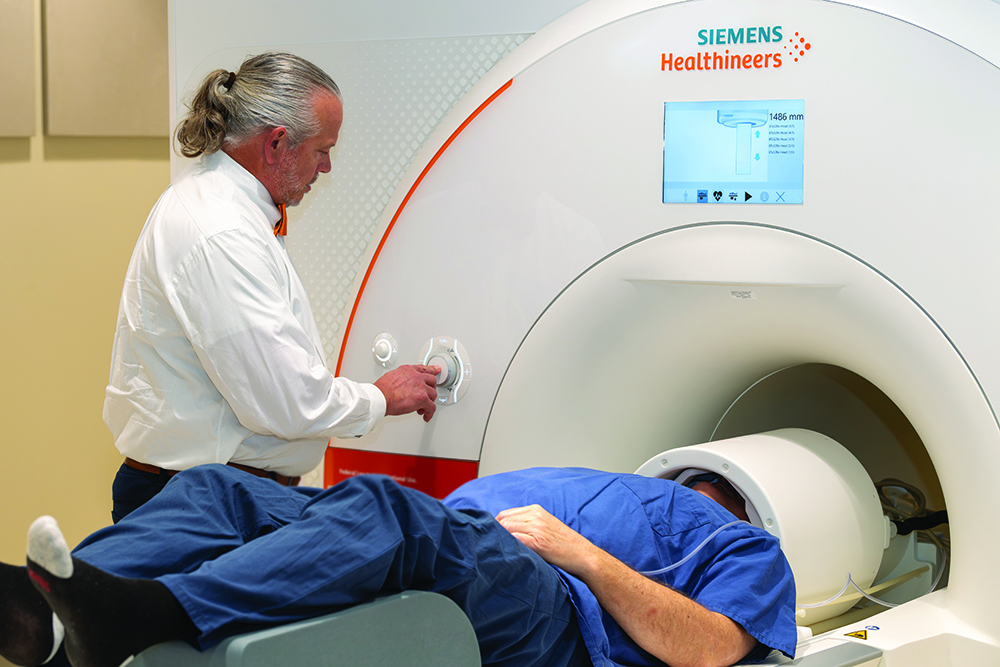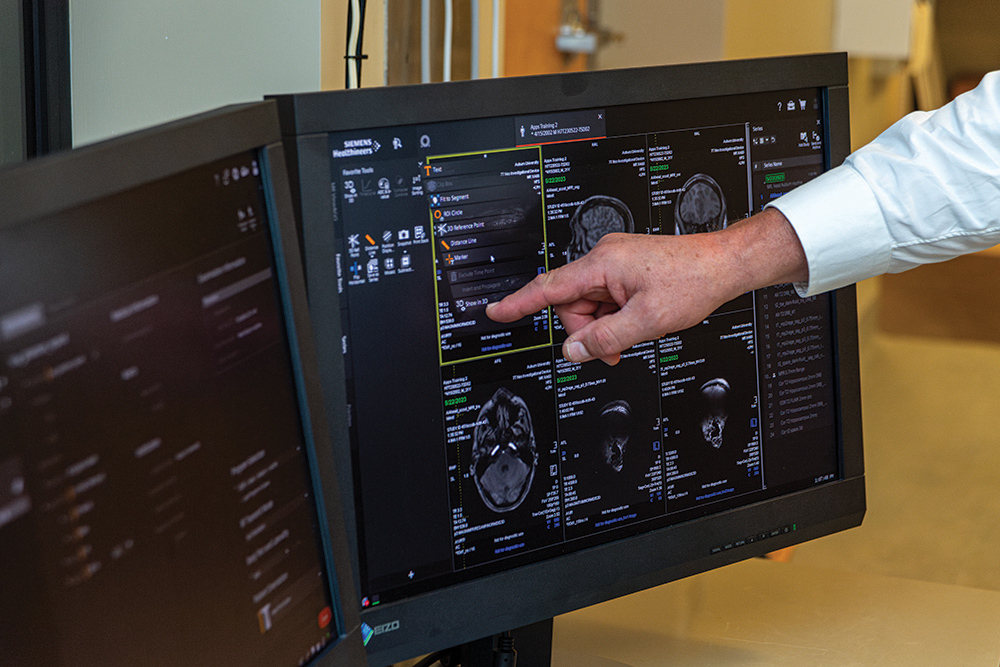
Auburn is home to the first field-installed, clinically approved whole-body Terra.X 7 Tesla MRI scanner, expanding the window for cutting-edge research and public use.
Gopikrishna Deshpande wants to see the brain in action.
How does information between billions of neurons flow within this cerebral superhighway? What functional details impact decision-making or even clinical disorders such as autism or Alzheimer’s?
Now, he can.
The recently approved $9 million Siemens MAGNETOM Terra.X 7 Tesla (7T) magnetic resonance imaging (MRI) scanner inside the Auburn University Neuroimaging Center takes researchers to places they’ve never been and provides them with detailed, ultra-high-resolution images they previously could not study. The world’s first field-installed, clinically-approved parallel transmit 7T MRI scanner complements the center’s 3T scanner, part of its original equipment that’s still used today.
“3T scanners are standard in clinical practice today, and you get a fairly good view of what’s happening in the brain — but you miss a lot of the details,” said Deshpande, a professor of electrical and computer engineering, who specializes in signal/image processing. “Because the brain is such a complex organ with billions of neurons and trillions of connections, the devil is in the details. As researchers, we want to have as much detailed depiction, with high-resolution images, as possible. Now we can gain a better understanding of basic science. Once this understanding is obtained, we can begin to translate this to clinical conditions. What is happening in their brain? Which connections inside the brain are not working as they should? Once we better understand this, it becomes easier to devise interventions and therapies.”
For Auburn University, installing the powerful whole-body Terra.X 7 Tesla scanner was… a no-brainer.

“The university is sitting on a gold mine in terms of data and capabilities,” said Thomas Denney, director of the Auburn University Neuroimaging Center and the Mr. & Mrs. Bruce Donnellan & Family Endowed Professor in the Department of Electrical and Computer Engineering. “This machine puts us on the map in the MRI universe, and it allows us to play in a sandbox that we couldn’t play in before. Additional equipment like this new 7T puts us in the same category as the nation’s large medical research centers and allows us to hire people we could not have hired before.”
What makes this 7T scanner so powerful? Denney said updated scanners are fitted with parallel transmit technology and sodium imaging capability. Why is this important?
“With our old 7T, if we did an MRI scan of the brain in certain regions, you wouldn’t receive uniform coverage of the brain,” Denney said. “That’s because we had only one transmit channel — like a flashlight inside a large room with only one beam. By comparison, our new Terra.X 7 provides us with eight beams of light that illuminate the brain and provide a more uniform image. Sodium imaging technology is important because it can measure how much sodium is in your brain regionally and identify abnormalities.”
Steve Taylor, senior vice president for research and economic development, said the university has opportunities to solve mysteries previously left unexplained.
“Impactful, multi-disciplinary research remains one of the foundations of our rich history as a university, and the door is open to creative explorations into neuroscience that we, or no peer institution, had previously,” he said. “I’m excited to watch researchers from across campus take advantage of this powerful resource.”
Denney noted that Auburn researchers, many whom have already utilized the center’s previous 7T and 3T equipment, will take advantage of this new avenue. Fresh research explorations already underway include:
• Meredith Reid, assistant professor in electrical and computer engineering, is exploring post-traumatic stress disorder biomarkers in senior adults via spectroscopy.
• Jennifer Robinson, professor in psychological sciences, compares brain connectivity between healthy populations and those with mental illness, focusing on cognition and emotions.
• Adil Bashir, associate professor in electrical and computer engineering, is studying muscle and brain energy production capacity on the cells and determining mitochondrial metabolic homeostasis using phosphorus spectroscopy.
• Doug Martin, director of the Scott-Ritchey Research Center and professor of anatomy, physiology and pharmacology at the College of Veterinary Medicine, is using MRI and spectroscopy to measure the effect of gene therapy for Tay-Sachs disease in animal models.
“Our vision is to become a leading center for MRI research with emphasis on brain imaging, cardiovascular imaging and orthopedic imaging,” Denney said. “These areas represent an intersection between the needs of the MRI research community, particularly in 7T imaging, and existing expertise and strengths of Auburn University.”
The Center’s previous 7T system, installed in 2012 and removed, was an investigational-only device.
The university’s open bore 3T scanner, installed in 2010 and upgraded to a Siemens Skyra in 2021, remains on site and will continue to be utilized.
Turn the clock back to February 2010.
Auburn football was months away from kicking off an unexpected national championship football season; Jay Gogue was in his first term as Auburn University president; Larry Benefield was dean of engineering; and, what originally opened as the Auburn University MRI Research Center, a ribbon was ceremoniously cut on a $20 million, 45,000-square foot facility.
Since then, the center has seen tremendous updates in technology and received a new name: the Thomas Walter MRI Research Building at the Auburn Research Park.
Its namesake, Thomas Walter, ‘55 engineering physics, made a generous gift to the center in 2021 that would eventually make the purchase of the new 7T possible.
“I dreamed of building an MRI research program here at Auburn where large medical centers recognize our contributions,” Denney said. “Through research, Auburn University has moved the needle and more than exceeded my expectations. Since opening this building, we’ve been able to double our staff. Those machines are great, but people are the ones who write research papers, and people are the ones who earn those research grants.”
People like Deshpande.
“MRI research has come a long way — and it will continue to evolve,” Deshpande said. “But I’m proud that Auburn University is a leading player in this field as my colleagues and myself continue to explore the unexplored, explain the unexplained and provide impactful research to improve the quality of life for all.”
LEAVING A LEGACY
The Thomas Walter MRI Research Building was named for Walter in recognition of a generous contribution from him and his wife, Jean. The Walters have been dedicated benefactors of Auburn University and the Samuel Ginn College of Engineering for more than two decades.
Tom attended Auburn, then known as API, on a Naval ROTC scholarship and graduated with a bachelor’s degree in engineering physics in 1955. In the four years following his graduation, he served initially aboard an Atlantic Fleet destroyer and later with the Armed Forces Special Weapons Project.

Following four years of active duty, Walter worked as a circuit design engineer at Texas Instruments and later as a systems engineer at IBM. In 1961 he was licensed as a Professional Engineer. In 1963 he joined EDS, an information service company, where he served in numerous managerial positions including as a member of its board of directors, senior vice president and chief financial officer.
In 1989, a gift of $2.6 million was made to Auburn University in Walter’s honor to establish the Thomas Walter Center for Technology Management. This center unites businesspeople, engineers and faculty seeking the best balance of technological and managerial know-how to win in the global marketplace. The gift to establish the center also funded an eminent scholar chair in technology management. A milestone in this area was reached with the inauguration of a joint program between the College of Engineering and the College of Business leading to a minor in business-engineering-technology. Walter figured prominently in the program’s development, and significantly more advanced training now exists for students thanks to his work.
Tom and Jean have demonstrated a strong commitment to the university. The Walters are life members of the Auburn Alumni Association, and they have provided scholarship support within engineering, science and math, and agriculture, including the James H. Hall Scholarship in honor of Jean’s father. They have also provided a number of professorships, chairs and endowments.
The Walters are members of the university’s Foy Society and engineering’s Ginn Society, and they have spent much time coming to Auburn to support and be involved with the Auburn University Foundation, where Tom served on the board of directors for 18 years. For his professional achievements and philanthropic endeavors, Tom was inducted into the State of Alabama Engineering Hall of Fame in 2003, was named as a Distinguished Auburn Engineer in 2017 and received the Auburn Alumni Association’s Lifetime Achievement Award in 2023.